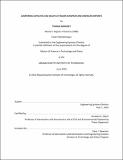| dc.contributor.advisor | Amedeo R. Odoni. | en_US |
| dc.contributor.author | Morisset, Thomas (Thomas Marc) | en_US |
| dc.contributor.other | Massachusetts Institute of Technology. Technology and Policy Program. | en_US |
| dc.coverage.spatial | e------ n-us--- | en_US |
| dc.date.accessioned | 2011-11-18T21:01:56Z | |
| dc.date.available | 2011-11-18T21:01:56Z | |
| dc.date.copyright | 2010 | en_US |
| dc.date.issued | 2010 | en_US |
| dc.identifier.uri | http://hdl.handle.net/1721.1/67212 | |
| dc.description | Thesis (S.M. in Technology and Policy)--Massachusetts Institute of Technology, Engineering Systems Division, 2010. | en_US |
| dc.description | Cataloged from PDF version of thesis. | en_US |
| dc.description | Includes bibliographical references (p. 73-76). | en_US |
| dc.description.abstract | Successful air transport systems must satisfy the demand for flights while maintaining a high level of service and safety. For airports, which have limited capacities, policy-makers must compromise between maximizing the number of flights served and avoiding excessive delays. Differences between policies adopted in the US and in Europe result in distinct airport performances, the analysis of which reveals best practices. The first point of comparison is over the capacities of a set of the busiest airports in the US and Europe. Under radar-based air traffic control procedures, Instrument Flight Rules (IFR), American airports achieve equal or higher capacities than European airports with similar runway layouts. These discrepancies cannot be explained by the differences in separation requirements alone. Besides, through their extensive use of Visual Flight Rules (VFR), weather permitting, American airports gain an important premium on their capacities. US air traffic control practices and policies clearly result in a more efficient use of airport infrastructure. Second, arrival delays relative to schedule increase over the course of the day at the US airports, while they remain mostly constant in Europe. Similarly the distributions of these delays show that schedule reliability at airports is significantly better in Europe than in the US. These comparisons underscore the benefits of Europe's policy of airport slot-controls, which cap the number of aircraft movements at a declared capacity. Moreover, arrival delays in the US are much higher under IFR (23 minutes average) than VFR (9 minutes). This shows that the high variability of the capacity of US airports depending on weather conditions, coupled with the tendency toward over-scheduling of flights, is damaging to the national airport system's stability and reliability. From these comparisons stem a few policy recommendations. Airline schedule reliability might benefit from additional controls or economic incentives to rationalize the scheduling of aircraft movements at some US airports. At the same time, some European airports could benefit from increasing their declared capacities. More generally, European aviation authorities should consider relaxing air traffic control separation procedures along the lines of US practices. | en_US |
| dc.description.statementofresponsibility | by Thomas Morisset. | en_US |
| dc.format.extent | 76 p. | en_US |
| dc.language.iso | eng | en_US |
| dc.publisher | Massachusetts Institute of Technology | en_US |
| dc.rights | M.I.T. theses are protected by
copyright. They may be viewed from this source for any purpose, but
reproduction or distribution in any format is prohibited without written
permission. See provided URL for inquiries about permission. | en_US |
| dc.rights.uri | http://dspace.mit.edu/handle/1721.1/7582 | en_US |
| dc.subject | Engineering Systems Division. | en_US |
| dc.subject | Technology and Policy Program. | en_US |
| dc.title | Comparing capacities and delays at major European and American airports | en_US |
| dc.type | Thesis | en_US |
| dc.description.degree | S.M.in Technology and Policy | en_US |
| dc.contributor.department | Massachusetts Institute of Technology. Engineering Systems Division | |
| dc.identifier.oclc | 759082506 | en_US |
